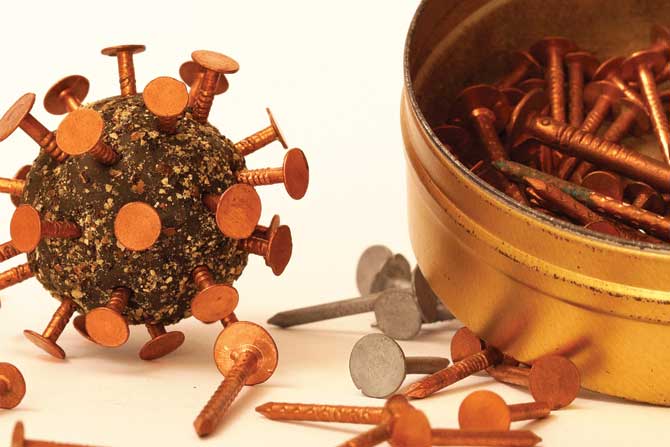By Utah Mining Association
Utah is known for its copper mining. But fewer people know about copper’s potential role as an effective antimicrobial against health threats that include the following:
- Cholera
- Coronaviruses that include COVID-19
- MRSA
- Norovirus
- Virulent strains of E-coli
Anciently, some people did understand that copper could help fight disease. The Smith Papyrus, written sometime 2600-2200 B.C., contains a description of copper’s first medical use. The document says copper was used at that time to sterilize water and wounds. According to other records, Babylonian and Egyptian soldiers would take shavings from their bronze swords and use them to reduce infections. (Bronze contains copper and tin.)
It took a long time for science to catch up. Thanks to Victor Burq (1822-1884), scientists and medical professionals have known copper had antimicrobial properties against cholera for more than 168 years. Victor Burq worked as a physician in France, and during his time there, he visited a copper smelting facility in April 1852. He figured out there had to be a connection between copper and its effectiveness against cholera after discovering that no one who worked at that or other nearby copper smelters died of cholera during cholera epidemics in 1832, 1849 and 1852; the few who did get sick had mild cases. Living conditions in the smelter were poor, and those who lived there had high mortality rates from other causes. The only explanation for immunity to cholera had to be related to copper.
Burq did a survey that eventually involved 300,000 people in Europe and compiled statistical data tables drawn from the responses. Those tables are currently in the Académie de Médecine’s library in Paris. They made it clear that copper was as effective against cholera as quinine sulfate was against recurring malarial fevers. Additional research during the cholera epidemics of 1854 and 1855 allowed him to discover that jewelers, goldsmiths, boilermakers and people who played brass instruments also stayed well. During an 1865 epidemic, 3.7 people per every 1,000 died of cholera. For people who worked with copper, the fatality rate was 0.5 per 1,000.
By 1867, after additional research on 400 different Paris businesses and factories, and after collecting reports on more than 200,000 people in England, Sweden and Russia, he determined that copper could be used to prevent cholera.
Some architects took note. For example, New York City’s Grand Central Station has a grand staircase with antimicrobial copper handrails.
How does copper kill microbes?
- Karrera Djoko, a biochemist and microbiologist at England’s Durham University, says copper releases ions that can puncture and access germs to affect its genetic material.
- Michael Johnson, a microbiologist at the University of Arizona, says copper replaces other metal ions within a cell or virus; since metal ions are in about 40% of proteins with known structures, the copper metal ions can inhibit or destroy those proteins. Even though 40% is not 100%, it’s enough to shut the proteins down.
- Michael Schmidt is a professor. He teaches microbiology and immunology at the Medical University of South Carolina; he says copper interacts with oxygen to create free radicals that explode viruses (including their DNA and RNA) on contact. Once destroyed, they can no longer mutate to resist copper or pass genes on to other microbes, which means copper will continue to be effective. That matters when so many antibiotic-resistant bacterias have become common.
- Researchers have learned that immune cells called macrophages envelop and separate germs in an acidic chamber. The macrophages then spike the chamber with copper doses.

In short, touching copper is the equivalent of sanitizing your hands. It doesn’t replace avoiding the virus by wearing masks, washing hands or social distancing — especially since the virus seems to be transmitted most by airborne particles, not contact with infected surfaces — but it is another defensive tool.
Manufacturers have seen the sales opportunity of adding copper to products such as socks or masks. There are two concerns to be aware of, according to Djoko:
The amount of copper in a product matters. If a mask is 1% copper and 99% of something else, like fabric, it does not have enough copper to make a difference against the coronavirus.
Many household cleaners can strip off copper ions when a copper-laced mask is being frequently washed or disinfected.
Wearing a mask, in general, is more important than whether that mask contains copper. But using an adequate amount of copper in masks, combined with increasing the number of copper touchpoints, especially in high-traffic public places such as hospitals, could make a difference as everyone continues the fight against the pandemic and other hard-to-kill diseases.
Since copper’s microbial properties have been understood for so long, why isn’t copper already commonly used to make products such as beds, doorknobs and railings? Michael Schmidt attributes it to arrogance and a preference for cheaper materials like aluminum, plastic and stainless steel.
That may finally come to an end, especially since many harmful microbes can live on hard surfaces for up to five days. In 2015, for example, when medical researchers were studying human coronavirus 229E, they found it could infect lung cells five days after being on surfaces such as the following:
- Ceramic
- Glass
- Silicone rubber
- Stainless steel
- Teflon
People may prefer the look of polished copper to tarnished copper, but is polishing important if copper prevents infection and saves lives regardless?
That wasn’t true of copper surfaces, which quickly deactivated the coronavirus.
When people touch an infected surface, it’s easy for the microbes to infect people through their eyes, mouth or nose. According to Michael Schmidt, combining standard hygiene protocols with copper touchpoints reduces the bacteria in medical hospitals and offices by 90%. According to a study in 1983, something as simple as replacing a stainless steel hospital doorknob with a copper one can eradicate E. coli growth.
There are 1.7 million healthcare-associated infections (HAI) that result in 99,000 deaths annually. The annual cost of treatment (successful or not) is between $35.7 and $45 billion. For the current pandemic, a study in a Montana virology lab by the National Institutes of Health showed that spraying the COVID-19 virus onto common materials such as plastic and stainless steel could still potentially spread the disease for three days. When sprayed on copper, however, SARS-CoV2 was gone after four hours. Copper was more effective than any other material tested at killing the virus.
Bill Keevil, a professor at the University of Southhampton in England who teaches environmental health care, is a fan of copper and has received funding from the Copper Development Association. He would like to see copper used in hospitals, public transportation systems, gyms and everyday objects such as pens. Doing so, he thinks, could reduce transmission of respiratory diseases.
A three-hospital clinical trial in 2012 that was performed by Schmidt and other colleagues in New York City and Charleston found that patients were endangered by microbe contamination of the items that were closest to them: arms of the visitor chair, bed rails, the call button, the I.V. pole and the tray tables. Copper on just those items reduced microbe presence by 83% and HAIs by 58%, even though the copper was on less than 10% of the room’s surface area.
Are there other ways to kill the bacteria and viruses that can cause HAIs? Yes: ultraviolet light and hydrogen peroxide gas both work. But they are harder to use. Copper is passive; actively decontaminating a room is not. Also, a room can easily become recontaminated. Copper continues to work regardless.
Additional benefits are clear:
- There is plenty of copper. It isn’t going to run out soon.
- Almost all copper can be recycled, and it is still effective afterward.
- It does not wear out or lose its ability to kill microbes.
Copper is not the only antimicrobial metal; silver is another one. But silver is ineffective when it is dry. Copper can be dry or wet. It even continues to work when it is tarnished. People may prefer the look of polished copper to tarnished copper, but is polishing important if copper prevents infection and saves lives regardless?
Is copper too expensive? According to a 338-day study done by Keevil and Schmidt in 2015, copper prevented 14 infections and saved $397,600 in treatment costs for HAI. (To determine this number, they figured out how expensive each HAI was per patient, minus the price to install copper on 10% of the surfaces, and compared the results to the equivalent medical expenses when copper was not used.)
Imagine how much copper could have helped the U.S. in March 2020. Imagine how much of a difference it could still make now.












